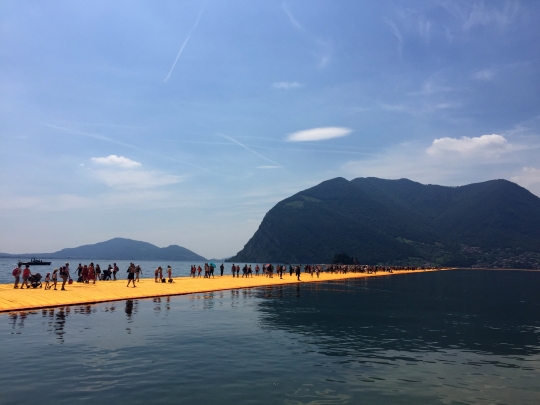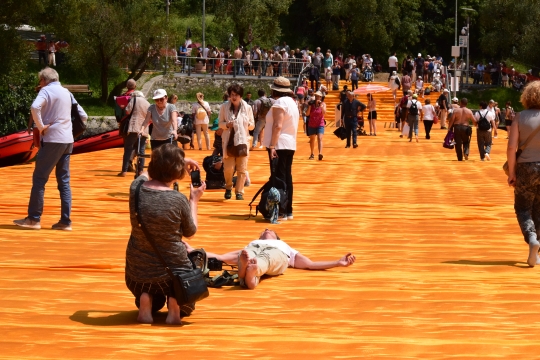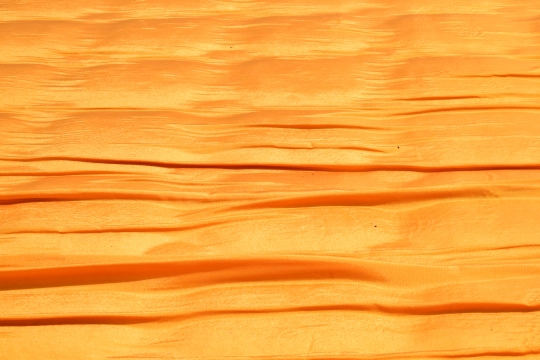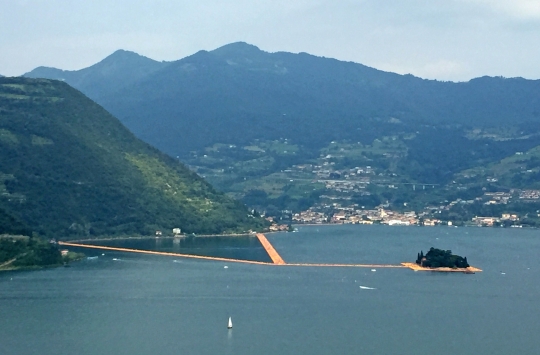Art Makes Community: Floating Piers at Lago Iseo
Art Makes Community: Floating Piers at Lago Iseo

On June 18, 2016, the man who greatly influenced the modern era of Public Art—Bulgarian-born artist Christo—opened his latest installation to the public, at picturesque Lake Iseo in Northern Italy.
This is the first solo project of Christo's since Jeanne-Claude, his wife and artistic collaborator on 75 projects worldwide, passed away in 2009. Christo makes it very clear that there is no Christo without Jeanne-Claude. Still his art goes on.
The Floating Piers project was conceived in 1970 and originally planned for Rio Brato and the bay of Tokyo until political hurdles got in the way. But now, at 81 years of age, still brimming with energy and unstoppable resilience, Christo was finally able to transform his vision into reality. For only 16 unique days he created art that allows people to walk on the water of the Italian Lake Iseo!
My journey to The Floating Piers began when a friend sent me a link to the New York Times article in February this year with a short note: “I think you should go there! This is in your backyard!” This is what I appreciate about my profession and the architecture world in general. It is not just a job from eight to midnight (LOL.) No, it really is a part of your life! We architects see the world through a different prism! Small details, for example, which direction the wood planks in a building should run, keep us up at night. Architects travel to a multitude of destinations to absorb different cultures, buildings and human habitation in all their wondrous and varied forms. Here at Moore Ruble Yudell I found a community that shares these values, what can be learned from other cultures, the harmony between place and building and the choreography of human interaction.

With all this in mind I decided to pack my suitcases once again and fly back to my first home, the Lake of Constance in Southern Germany. From there I took a sleek Swiss train, complete with a beautiful bar/café car, and traveled to Milan Italy in only four hours’ time. The journey took us along wonderful deep blue Swiss - Italian lakes, while offering serendipitous views of rolling green meadows, charming small towns and impressive views of the monumental Alps.
Waiting in Milan was a dear friend and architectural colleague from Marseilles, France. We spent one night in the fashion capital of Milan, exchanging views on life and architecture over a delicious Italian dinner capped off with sweet gelato.
"The Floating Piers is absolutely free and accessible 24 hours a day – weather permitting," said Christo. "There are no tickets, no openings, no reservations and no owners. [They] are an extension of the street and belong to everyone."
The essential joy of this trip depended a lot on getting the logistics right. Lake Iseo is the quieter sibling in the shadow of Lake Lugano which attracts scores of German tourists as well as the George Clooney/celebrity-infused Lake Como. Local infrastructure and parking appeared challenged by the unexpected numbers of people, up to 100,000 visitors per day there to take in The Floating Piers. Our strategy (which fortunately worked out well) was to avoid parking issues and long lines, predicted by the media and travel to the opposite site of the lake. So instead of starting at Sulzano, the official beginning of the three kilometer long walkway, we were on our way to the opposite small town of Tavernolo. There we would take a boat to the island of Monte Isola.

The Floating Piers was constructed using 100,000 square meters of shimmering saffron-yellow fabric, carried by a modular floating dock system of 220,000 high-density polyethylene cubes. The installation—which sits just above water level—undulates with the movement of the lake. The piers are sixteen meters wide and approximately thirty-five centimeters high, with sloping sides. Professional deep – sea divers connected the supporting steel frames with steel piers and anchored these to the bottom of the sea.
The Floating Piers connect the mainland in Sulzano with Monte Isola and the small island of San Paolo. The fabric continuum extends along two kilometers of pedestrian streets in the towns of Sulzano and Peschiera Maraglio. At the end of its glorious and too brief sixteen day life span, the entire installation will be removed and completely recycled.
As we began the three kilometer long walk on Monte Isola we marveled again at the reports that Christo completely self-funded the entire installation. Wondrously gleaming textile led us and numerous other folks to the beginning of the actual "floating piers" portion. While there were people in great masses, there was a general calmness and a remarkably relaxed atmosphere. Everyone seemed to share the same interest in the experience and of course, an appreciation for the artist himself. As recommended by Christo, we took our shoes off and tread barefoot on the wonderful yellow textile. The fabric was sewn into place by German seamstresses with specially-made sewing machines and creates natural ruching. We experienced the wonderful sensation created by the texture of the textile and the undulations of the moving cubes. The artist describes the experience as akin to “walking on the back of a whale.”
No guard rails marred the clean lines of the piers. Over 130 lifeguards and diving professionals were present to provide general security and information about the project. Less liability litigation and more “common sense” as practiced in countries like Italy allow these types of installations. And well, if you are not careful you take a dip into the refreshing blue water!

The shimmering saffron-colored piers created a perfect contrast to the deep green of the surrounding mountains and dark blue of the water. This inclusive project invited everyone – young parents with strollers, the individual Italian fashionista, an elderly person with a walker, people in wheel chairs, small groups, large groups, two-legged as well as four-legged species! It was amusing to observe the different poses people developed for pictures or selfies. In the end, The Floating Piers was not the only art on display, finally it became the canvas to display the multitudes there, and that's what made this experience complete and unique.
The general sense of relaxation and joy experienced throughout the entire walk was remarkable considering the masses participating in this “public” event. This is the value, the special impact of public art, appreciated all the more in the context of our challenging times when terrible incidents such as the bombings in Paris or the attack in Nice create fear in community gatherings.
It was also impressive how quickly and easily we could buy food and beverages. Simple furniture was organized in the shade of over-arching olive trees. College kids, earning some extra money in the summer, helped serve the small selection of panini and fresh salads made with locally harvested ingredients, and offered at very modest prices. There was not your typical “Exit Thru the Gift Shop” at the end of the experience – only a few women selling hand-crafted goods.
Christo's aim was to bring the customs and qualities of the region closer to the visitor. TASCHEN was the only commercial stand selling its publication of The Floating Piers project.
A true highlight was the appearance of Christo himself on a separate boat. He seemed almost a conductor, carefully observing the orchestration of his art and the public's interaction with it, from a distance. There was a special moment as the thousands of people present, paused to salute the man responsible for this unique installation and experience!
After my return to the United States I have been asked many times, “what is The Floating Piers?” And I think Paul Goldberger’s quote sums up the experience quite well: “at once a work of art, a cultural event, a political happening and an ambitious piece of business.”
* all photographs by Simone Barth
